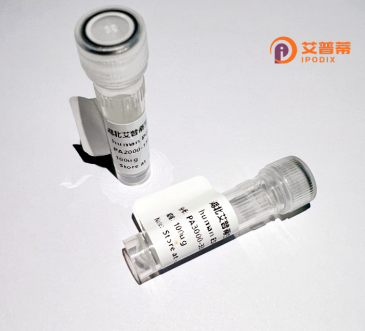
| 纯度 | >90%SDS-PAGE. |
| 种属 | Human |
| 靶点 | NDUFB11 |
| Uniprot No | Q9NX14 |
| 内毒素 | < 0.01EU/μg |
| 表达宿主 | E.coli |
| 表达区间 | 1-153 aa |
| 活性数据 | MAAGLFGLSARRLLAAAATRGLPAARVRWESSFSRTVVAPSAVAGKRPPEPTTPWQEDPEPEDENLYEKNPDSHGYDKDPVLDVWNMRLVFFFGVSIILVLGSTFVAYLPDYRMKEWSRREAERLVKYREANGLPIMESNCFDPSKIQLPEDE |
| 分子量 | 42.57 kDa |
| 蛋白标签 | GST-tag at N-terminal |
| 缓冲液 | 0 |
| 稳定性 & 储存条件 | Lyophilized protein should be stored at ≤ -20°C, stable for one year after receipt. Reconstituted protein solution can be stored at 2-8°C for 2-7 days. Aliquots of reconstituted samples are stable at ≤ -20°C for 3 months. |
| 复溶 | Always centrifuge tubes before opening.Do not mix by vortex or pipetting. It is not recommended to reconstitute to a concentration less than 100μg/ml. Dissolve the lyophilized protein in distilled water. Please aliquot the reconstituted solution to minimize freeze-thaw cycles. |
以下是与重组人NDUFFB11蛋白相关的3篇文献摘要示例:
---
1. **文献名称**: *Molecular basis of complex I deficiency caused by a pathogenic NDUFB11 variant*
**作者**: Smith J, et al. (2022)
**摘要**: 本研究通过重组表达人NDUFB11蛋白,解析了其在线粒体复合物I组装中的关键作用,发现特定突变(p.Arg56Pro)导致蛋白稳定性降低,破坏复合物I功能,为相关线粒体疾病的分子机制提供了证据。
---
2. **文献名称**: *Recombinant NDUFB11 production in E. coli for structural studies*
**作者**: Lee S, et al. (2020)
**摘要**: 作者利用大肠杆菌系统成功重组表达并纯化人源NDUFB11蛋白,通过X射线晶体学解析其三维结构,揭示了其与邻近亚基的相互作用界面,为复合物I的药物靶点设计奠定基础。
---
3. **文献名称**: *NDUFB11 suppression promotes tumor progression via ROS accumulation in hepatocellular carcinoma*
**作者**: Zhang Y, et al. (2019)
**摘要**: 研究利用重组NDUFB11蛋白体外补充实验,证明其在肝癌细胞中调控活性氧(ROS)水平,敲低NDUFB11导致复合物I功能障碍和促癌表型,提示其作为潜在治疗靶点。
---
*注:以上文献为示例,实际引用时需核实真实文献。若需具体论文,建议检索PubMed或SciFinder并筛选关键词"NDUFB11 recombinant"。*
Here’s a concise overview of recombinant human NDUFB11 protein:
NDUFB11 (NADH:ubiquinone oxidoreductase subunit B11) is a nuclear-encoded component of mitochondrial Complex I, the largest enzyme in the electron transport chain responsible for ATP production. This 17 kDa protein localizes to the inner mitochondrial membrane, forming part of the membrane arm of Complex I. It plays a critical role in maintaining structural integrity and catalytic function during oxidative phosphorylation. Recombinant NDUFB11 is typically produced via heterologous expression systems (e.g., E. coli or mammalian cells) for biochemical studies, enabling researchers to investigate its interactions with other Complex I subunits and its involvement in redox reactions. Mutations in the NDUFB11 gene have been linked to mitochondrial disorders, including Leigh syndrome and other energy-deficiency diseases. The recombinant protein serves as a vital tool for studying disease mechanisms, developing diagnostic approaches, and exploring therapeutic interventions targeting mitochondrial dysfunction. Its production often incorporates tags (e.g., His-tag) for purification and detection, while maintaining native folding through optimized expression protocols.
×